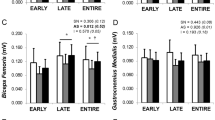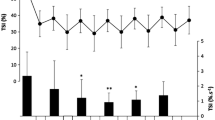Summary
Eight male sprinters were filmed running three maximal starts over 3 m on a long force platform. The subjects were divided into two groups (n=4) according to the leg on which the electromyograph (EMG) electrodes were fixed. When in the set position one group had electrodes on the front leg (FLG) and the other group on the rear leg (RLG). The EMG activities of the gastrocnemius caput laterale muscle (GA), vastus lateralis muscle (VL), biceps femoris caput longum muscle (BF), rectus femoris muscle (RF) and gluteus maximus muscle (GM) were recorded telemetrically using surface electrodes. Total reaction time (TRT) was defined as the time from the gun signal until a horizontal force was produced with a value 10% above the base line. Pre-motor time was defined as the time from the gun signal until the onset of EMG activity and motor time (MT) as the time between the onset of EMG activity and that of force production. Reproducibility of the reaction time variables was satisfactory (r=0.792–0.89; coefficient of variation= 8.8%–11.6%). The TRT was 0.121 s, SD 0.014 in FLG and 0.119 s, SD 0.011 in RLG. The MT ranged from 0.008 s, SD 0.009 (GM) to 0.057 s, SD 0.050 (GA) in FLG and from 0.018 s, SD 0.029 (GA) to 0.045 s, SD 0.009 (GM) in RLG. In some individual cases there were no MT values before horizontal force production. Significant positive correlations were observed between MT and maximal horizontal force and the velocity of the centre of gravity during the last observable contact on the blocks (P<0.05–0.01). The EMG activities of the muscles analysed demonstrated large individual variations until the end of the first contact after the blocks. This resulted in non-observable MT in some individual cases. In general, however, despite the complex multijoint character of TRT, its fractions could be analysed during the early phases on the blocks. To optimize starting action it is desirable that all the important muscles should be activated before any force can be detected against the blocks.
Similar content being viewed by others
References
Basmajian JV (1974) Muscles alive; their functions revealed by electromyography. Williams and Wilkins, Baltimore, MD, pp 23–27
Basmajian JV (1978) Muscles alive, 4th edn. Williams and Wilkins, Baltimore, MD, pp 12, 169–174
Baumann W (1976) Kinematic and dynamic characteristics of the sprint start. In: Komi PV (ed) Biomechanics VB. University Park Press, Baltimore, pp 194–199
Baumann W (1979) Sprint start characteristics of female sprinters. In: Ayalon A (ed) Proceedings of an international seminar in biomechanics of sport games and sport activities. June, 22, Netanya, Israel, pp 80–86
Bell DG, Jacobs I (1986) Electro-mechanical response times and rate of force development in males and females. Med Sci Sports Exerc 18:31–36
Burke RE, Edgerton VR (1975) Motor unit properties and selective involvement in movement. Exerc Sport Sci Rev 3:31–81
Cavanagh PR, Komi PV (1979) Electromechanical delay in human skeletal muscle under concentric and eccentric contractions. Eur J Appl Physiol 42:159–163
Clarkson PM (1978) The effect of age and activity level on simple and choice fractionated response time. Eur J Appl Physiol 40:17–25
Dempster WT (1955) Space requirements of the seated operator. WADC Technical Report 55–159. Wright-Patterson Air Force Base, Ohio
Dietz V, Schmidtbleicher D, Noth J (1979) Neuronal mechanisms of human locomotion. J Neurophysiol 42:1212–1222
Dostal E (1981) Analyse der Reaktionszeiten im Sprint bei den Europameisterschaften in Prag 1978. Leichtathletiktraining 5/6:327–331
Henry MF (1952) Force-time characteristics of the sprint start. Res Q 21:301–312
Hoster M (1981) Weg-, Zeit- und Kraft-Parameter als Einflußgrößen beim Sprintstart in der Leichtathletik. Leistungssport 11:110–117
Hoster M, May E (1978) Überlegungen zur Biomechanik des Sprintstarts in der Leichtathletik. Leistungssport 8:267–273
Ikai M, Fukunaga T (1970) A study on training effect on strength per unit cross-sectional area of muscle by means of ultrasonic measurement. Int Z Angew Physiol 28:173–180
Ito A, Komi PV, Sjödin B, Bosco C, Karlsson J (1983) Mechanical efficiency of positive work in running at different speeds. Med Sci Sports Exerc 15:299–308
Komi PV (1985) Ground reaction forces in cross-country skiing. In: Winter DA, Norman RW, Wells RP, Hayes KC, Patla AE (eds) Biomechanics IXB. Human Kinetics, Champaign, Ill, pp 185–190
Kroll W (1974) Fractionated reaction and reflex time before and after fatiguing isotonic exercise. Med Sci Sports 6:260–266
Kuo S (1965) Numeral methods and computers. Addison Wesley, Reading, Mass, pp 234–235
Menely CR, Rosemier AR (1969) Effectiveness of four track starting positions on acceleration. Res Q 39:161–165
Mero A (1988) Force-time characteristics and running velocity of male sprinters during the acceleration phase of sprinting. Res Q 59:94–98
Mero A, Artman V (1984) Reaction times in the sprint and hurdle events in world championships in Helsinki. The Finnish Amateur Athletic Association
Mero A, Komi PV (1987) Electromyographic activity in sprinting at speeds ranging from submaximal to supramaximal. Med Sci Sports Exerc 19:266–274
Mero A, Luhtanen P, Komi PV (1983) A biomechanical study of the sprint start. Scand J Sports Sci 5:20–28
Mero A, Luhtanen P, Komi PV (1986) Segmentelle Krafterzeugung und Geschwindigkeit des Körperschwerpunkts in den Kontaktphasen beim Sprint. Leistungssport 16:35–39
Miller DI (1983) Biomechanical considerations in lower extremity amputee running and sports performance. In: Wood GA (ed) Collected papers on sports biomechanics. University of Western Australia, Department of Human Movement and Recreation studies, pp 74–76
Milner-Brown HS, Stein RB, Yemm R (1973) The orderly recruitment of human motor units during voluntary isometric contractions. J Physiol (Lond) 230:359–370
Moravec P, Ruzicka J, Susanka P, Dostal E, Kodejs M, Nosek M (1988) The 1987 International Athletic Foundation/IAAF Scientific Project Report. Time analysis of the 100 metres events at the II World Championships in Athletics. New Stud Athletics 3:61–96
Payne AH, Blader FB (1971) The mechanics of the sprint start. In: Vredenbregt J, Wartenweiler J (eds) Biomechanics II. Karger, Basle, pp 225–231
Sale DG, MacDougall JD, Upton ARM, McComas AJ (1983) Effect of strength training upon motoneuron excitability in man. Med Sci Sports Exerc 15:57–62
Schmidt RA, Stull GA (1970) Premotor and motor reaction time as a function of preliminary muscular tension. J Mot Behav 11:96–110
Schnauber H, Singer R (1975) Untersuchung des Kraftverlaufs beim Tiefstart. Leistungssport 5:433–438
Surburg RR (1977) The effect of proprioceptive facilitation patterning upon reaction, response, and movement times. Phys Ther 57:513–517
Vagenas G, Hoshizaki TB (1986) Optimatization of an asymmetric motor skill: sprint start. Int J Sport Biomech 2:29–40
Viitasalo JT, Komi PV (1981) Interrelationships between electromyographic, mechanical, muscle structure and reflex time measurements in man. Acta Physiol Scand 111:97–103
Weiss AD (1965) The locus of reaction time change with set, motivation and age. J Gerontol 20:60–64
Author information
Authors and Affiliations
Rights and permissions
About this article
Cite this article
Mero, A., Komi, P.V. Reaction time and electromyographic activity during a sprint start. Eur J Appl Physiol 61, 73–80 (1990). https://doi.org/10.1007/BF00236697
Accepted:
Issue Date:
DOI: https://doi.org/10.1007/BF00236697




